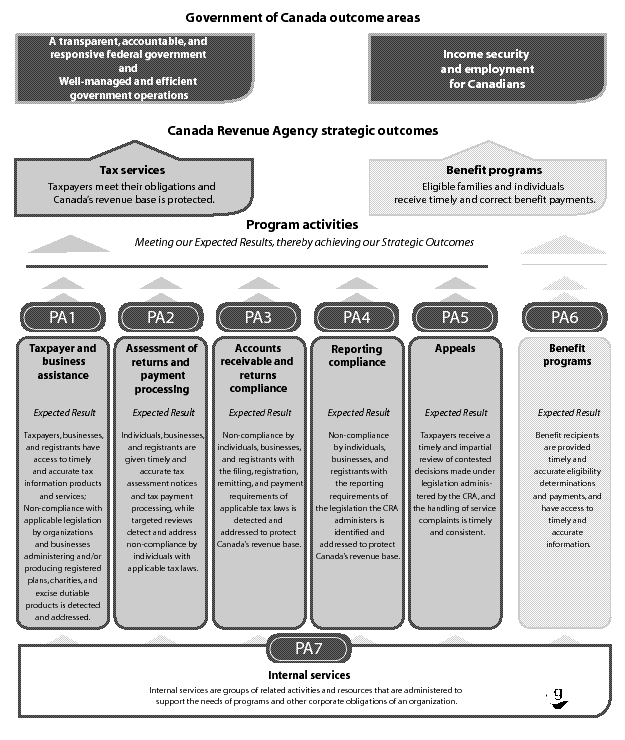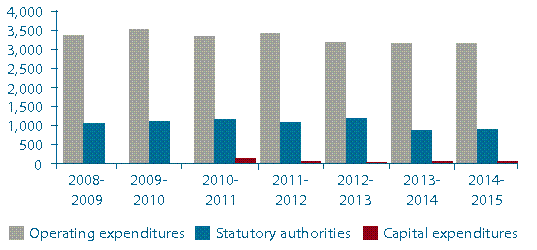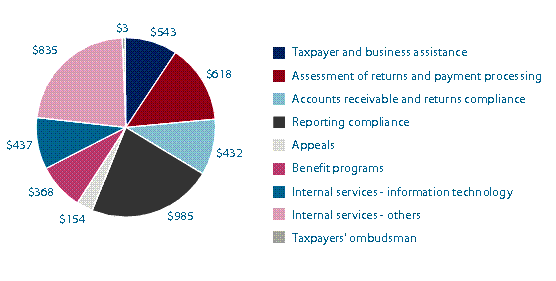Common menu bar links
Breadcrumb Trail
ARCHIVED - Canada Revenue Agency - Report
 This page has been archived.
This page has been archived.
Archived Content
Information identified as archived on the Web is for reference, research or recordkeeping purposes. It has not been altered or updated after the date of archiving. Web pages that are archived on the Web are not subject to the Government of Canada Web Standards. As per the Communications Policy of the Government of Canada, you can request alternate formats on the "Contact Us" page.
Message from the Minister
Our Government is committed to keeping taxes low, investing in jobs and growth, and controlling government spending. The CRA continues to provide programs and services that are critical to successfully carrying out this work and supporting Canadians as the economic recovery remains fragile.
Over the last year I have seen first hand the level of professionalism and dedication that the CRA invests in all aspects of its work with, and on behalf of individuals, businesses, and government clients. Over the period covered by this report, I am confident that they will continue to respond to the needs of Canadians in areas of service, information security, addressing non-compliance with tax laws, and administering benefit and credit programs. Through careful planning and monitoring we will adhere to our financial commitments while continuing to serve Canadians with excellence.
As Minister of National Revenue, I am proud to present the 2012-13 Report on Plans and Priorities for the Canada Revenue Agency.
The Honourable Gail Shea, P.C., M.P.
Minister of National Revenue
Message from the Commissioner
The Canada Revenue Agency (CRA) plays a central role in Canada's economy by administering tax, benefits, and related programs on behalf of Governments across Canada. This 2012-13 Report on Plans and Priorities (RPP) is an opportunity for us to set out how we will respond to the challenges and opportunities in our external and internal operating environment, in order to ensure that the CRA continues to be a world leader in tax and benefit administration.
The CRA recently embarked on a sweeping strategic planning process that culminated in the establishment of our Vision 2020. As a bridge from today into the future, Vision 2020 is a long term, transformative suite of strategies that will allow our organization to keep step with government priorities, technology, and taxpayer behaviour. In some ways, Vision 2020 is an extension of the CRA strategic agenda that has been in place for many years such as automation and self-service. In other ways, it reflects emerging best practices from tax administrations around the world and forms our blueprint for pursuing more productive and taxpayer centered ways of doing business.
In addition to our longer term transformative agenda, the CRA will be closely monitoring the evolution of Shared Services Canada to ensure the CRA continues to be well served with high quality information technology services. We are also committed to implementing action plans to respond directly to the recommendations of the Red Tape Reduction Commission. As well, we will respond to the spending review as part of the Government's efforts to reduce the deficit by implementing changes that move our organisation to a more efficient business model at the same time as transforming service and compliance so that we maintain our progress to Vision 2020.
I am proud to lead such a talented and knowledgeable workforce and I have tremendous confidence in the professionalism and dedication of CRA staff to deliver results for Canadians.
Linda Lizotte-MacPherson
Commissioner of Revenue
Section I: Organizational overview
Raison d'être
The Canada Revenue Agency (CRA) is responsible for administering, assessing, and collecting hundreds of billions of dollars in taxes annually. The tax revenue it collects is used by federal, provincial, territorial and First Nations governments to fund the programs and services that contribute to the quality of life of Canadians. The CRA also uses its federal infrastructure to deliver billions of dollars in benefits, tax credits, and other services that support the economic and social well-being of Canadian families, children and persons with disabilities
In carrying out its mandate the CRA strives to ensure that Canadians:
- pay their required share of taxes;
- receive their rightful share of entitlements; and
- are provided with an impartial and responsive review of contested decisions.
Responsibilities
The taxes that the CRA levies and the credits it administers are primarily set out in the Income Tax Act and the Excise Tax Act. We also administer specialty legislation relating to the Canada Pension Plan, Employment Insurance and softwood lumber. We undertake many non-tax activities, as well, including those related to charities, tobacco, registered plans, and non-tax collections. Tax administration consists of several steps, beginning when taxpayers are registered in our automated systems using a Social Insurance Number for individuals or a Business Number for businesses. Taxpayers must report and pay tax owed (income tax for individuals) or collected on behalf of the government (e.g. payroll, goods and services tax, Canada Pension Plan contributions by businesses). Payments and return filing occurs at different times of the year depending on the type of tax and the category of taxpayer. We verify returns, payments, and registration or application data submitted for tax, benefit, and credit purposes to ensure that the information is accurate. Where individuals and businesses either unintentionally or intentionally fail to fully comply, we use a wide range of mechanisms in our verification and enforcement programs to induce taxpayer compliance and to protect Canada's revenue base. We provide recourse for those who do not agree with our assessment or reassessment decisions, and if necessary, we collect any outstanding debts.
The CRA also plays a vital role in supporting families and individuals across Canada. We help millions of Canadians by administering a range of ongoing and one-time benefit and tax credit programs on behalf of federal, provincial, and territorial governments. In some instances, legislation allows us to provide information to support the programs administered by our government clients. By ensuring that benefit recipients have access to timely and accurate information, we help them receive their proper entitlements. Equally important, by working as a single delivery service on behalf of several levels of government, we reduce duplication and the overall cost of administering benefit programs.
We are very aware of the importance that Canadians place on fairness and transparency in all interactions with government. We respond to Canadians' expectations by ensuring that only eligible individuals receive benefits and that their entitlements are correct. This protects benefit and credit recipients from undue hardship that could be caused by underpayments while protecting government revenues by reducing overpayments.
The CRA contributes to three of the Government of Canada's outcome areas:
- a transparent, accountable, and responsive federal government;
- well-managed and efficient government operations; and
- income security and employment for Canadians.
Strategic outcomes and program activity architecture (PAA)
Organizational Priorities
This Report on Plans and Priorities sets out the core programs that we will use to deliver our mission over the next three years. It also sets out the results of the CRA's recent strategic planning exercise that established nine clear strategic directions for the CRA and a major transformation agenda, to be launched early in 2012-2013.
Leading the change – Vision 2020
The CRA has a strong record of implementing improvements to keep pace with a fast-changing environment. Today's world is one in which businesses must compete globally for talent and markets, services are expected to be available 24/7, from any location and any technology, and governments are under pressure to cut spending while providing top quality, responsive and transparent services to citizens.
Tax administration is a key enabler of government objectives in this fast paced environment. Taxpayers' trust and participation in the tax system means that government has the revenue it needs to deliver jobs, growth and security for Canadians. Businesses count on us to be fair, clear and timely in our decisions about tax implications, so that they can move quickly on major decisions, and to minimize their paper burden. Canadians look to us to make it easy and stress-free to pay taxes, using services that fit in with their lifestyle, and to get it right when we pay benefits.
In 2010, we embarked on a comprehensive strategic planning process to keep the CRA in step with government priorities, technology, and taxpayer behaviour. The result –Vision 2020– is a bridge from today to the future.
Vision 2020 lays out a long term, transformative suite of nine strategic directions. Four relate to the range of activities from service to enforcement to recourse that we use to promote and sustain compliance. They describe an evolution in our approach to core business programs: Manage Compliance Intelligently, Integrate the Taxpayer Experience, Early Certainty about Tax Issues, and Influence Compliance Attitudes. Three are levers and describe the tools required to deliver Vision 2020: Extend our Reach through Third Parties, Drive to Electronic, and Better Data, Used Better. The remaining two are about ensuring we optimize our Organization's resources, and Build the Workforce and the Workplace of the Future.
The CRA has been moving in many of these directions for some time, for example we started providing e-services nearly two decades ago – but Vision 2020 challenges us to go farther, faster, so that we can deliver earlier results for Canadians. Vision 2020 began as a simple question: Are there better, more cost-effective ways for the CRA to meet its mandate? Building on guidance from bodies like the Organisation for Economic Cooperation and Development (OECD), our own best practices, and those of other leading tax jurisdictions, Vision 2020 sets out the directions that the CRA needs to pursue to continue as a modern, successful tax administration in challenging, dynamic times.
Our current plans are aligned with the following operational and management priorities for the CRA: promoting compliance, meeting service needs, addressing non-compliance, administering benefits, and enabling core business operations.
Risk analysis
OUR ENVIRONMENT
The CRA operates in an ever changing environment. Understanding the contextual trends and events found within this environment helps to set the context for risk identification and assessment. It also helps to develop an understanding of external and internal risks in a large, complex, and sophisticated organization such as the CRA.
Economy
Uncertainty surrounds the global economy, including the sovereign debt crisis in Europe, the United States' economic recovery, rising private debt, and high levels of unemployment in many industrialized nations. Domestically, the Canadian economy is seeing modest growth in the Gross Domestic Product (GDP) and it is expected that this modest trend will continue. Additionally, low interest rates are contributing to record levels of household debt and decreasing amount of household savings while the unemployment rate, despite improvement, is still elevated compared to pre‑recession levels. A strong or weak global or Canadian economy might have an impact on the level of revenues collected due to its influence on taxpayer behaviour. The state of the economy may also impact the number of Canadians who benefit from our services and programs.
International taxation
While globalization has created a number of economic benefits, it has also increased the complexity for tax administrators to collect taxes as it becomes less clear where income is earned and where taxes should be paid. The ability to move large amounts of money rapidly from one country to another helps those who want to avoid higher tax jurisdictions. To combat these issues, there is an increasing trend towards international collaboration among tax administrations, including joint audits of multinational corporations, and the support of bilateral and multilateral information exchanges.
Information technology
We are known for our ability to manage IT investments, integrate a strong IT architecture, ensure a secure IT environment, and leverage our significant amount of data and applications. However, many of our systems are aging and some of our technology is becoming outdated.
We are also faced with the need to become even more agile and responsive given the pace of change and innovation in the IT domain. IT change management capacity is essential in responding to our shifting needs as well as those of the Canada Border Services Agency (CBSA), for which we provide IT support. The need for an agile and flexible IT environment is heightened as Canadians continue to migrate towards electronic services. (e.g., electronic filing, My Account)
Workforce
We must proactively identify, recruit, and develop a representative workforce with the level of knowledge, competencies, and experience required to deliver on our mandate. Like many other institutions, we are dealing with an aging workforce and, consequently, an increase in the number of people eligible for retirement. There are technical and leadership areas where the number of pending retirements is more acute and are increasing the importance of ongoing succession planning and knowledge transfer.
The fact that we are also evolving in an environment that is in a state of ongoing fast-paced change is increasing the pressure that these workforce challenges will put on our ability to manage our activities and maintain the quality of programs and services.
Managing risk
Risk management is an important part of sound corporate governance. It helps organizations ensure that they have planned for the full range of potential circumstances and their possible impact on the organization's objectives. The CRA has a comprehensive enterprise risk management process that enables us to prioritize our efforts to keep risks from occurring or minimize their impact if they are due to unavoidable circumstances such as a natural disaster.
Our enterprise risk management is fully integrated into decision making, planning, and reporting to support the achievement of our strategic outcomes. The commitments in this Corporate Business Plan reflect our response to the identified major risks to the CRA's mandate. We fully expect that, as a result of our effective risk management, the public will continue to maintain its trust in the integrity and diligence of the national tax administration; our IT systems will be reliable and flexible to support our evolving service and compliance needs; we will address non-compliance that poses the greatest threat to Canada's revenue base; and our prudent management of corporate resources will result in a cost-efficient, productive organization.
Planning summary
Deficit reduction action plan
Please note that information on deficit reduction action plan measures is not included in this document. The information contained in this report will provide a baseline for future reporting on the impacts of the deficit reduction action plan for fiscal year 2012-2013. Please reference the 2012-2013 Departmental Performance Report for additional information regarding the implementation of the deficit reduction action plan.
CRA resources
Planning summary table
|
Taxpayer and business assistance (PA1) Footnote 2
|
|||||
|
We assess our results against our benefits strategic outcome by measuring timeliness and accuracy of payments and eligibility determination. We also monitor the number of government clients that rely on us as a service provider. Our targets vary between indicators. For information about service standard targets please see our Web site.
|
|||||
|
Total Agency (excluding taxpayers' ombudsman)Footnote 3
|
|||||
|
Taxpayers' ombudsman (PA9) Footnote 3
|
|||||
|
Total Planned Spending Footnote 4
|
|||||
- Footnote 1
- Planned spending does not include certain technical adjustments made in 2011-2012, primarily carry forward from the previous year ($178M) and maternity and severance benefits ($80M). These are in-year adjustments.
- Footnote 2
- Excludes forecasted disbursements to the provinces for the Softwood Lumber Products Export Charge Act, 2006, which are unavailable at this time ($140M in 2011-2012 and $280M in 2012-2013)
- Footnote 3
- Since the Taxpayers' Ombudsman operates at arm's-length from the CRA, this Report on Plans and Priorities does not reflect the activities of that office.
- Footnote 4
- Details may not add to totals due to rounding.
Our Contribution to the Federal Sustainable Development Strategy
The Federal Sustainable Development Strategy (FSDS) outlines the Government of Canada's commitment to improving the transparency of environmental decision-making by articulating its key strategic environmental goals and targets. The Canada Revenue Agency (CRA) ensures that consideration of these outcomes is an integral part of its decision-making processes.
The CRA contributes to Theme IV – Shrinking the Environmental Footprint – Beginning with Government as denoted by this visual identifier. These contributions are components of the following Program Activity and are further explained in Section II: Program Activity 7 – Internal Services.
For additional details on the CRA's activities to support sustainable development please see Section II of this RPP.
Complete details on the Federal Sustainable Development Strategy can be found on the Web site.
Expenditure profile
For the period 2008-2009 to 2011-2012, total spending amounts include all Parliamentary appropriations and revenue sources: Main Estimates, Supplementary Estimates, funding associated with the increased personnel costs of collective agreements, maternity allowances and severance payments, as well as funding to ensure implementation of Federal Budget initiatives and the Agency's carry forward adjustments from the prior year. It also includes spending of revenues received through the conduct of CRA's operations pursuant to Section 60 of the Canada Revenue Agency Act, Children's Special Allowance payments, payments to private collection agencies pursuant to Section 17.1 of the Financial Administration Act and disbursements to the provinces under the Softwood Lumber Products Export Charge Act, 2006. For the period 2012-2013 to 2014-2015, planned spending excludes carry forward adjustments which are only finalized once Public Accounts are completed and it also does not include any amounts for maternity allowances and severance payments. Finally, for the period 2013-2014 and 2014-2015 planned spending amounts do not yet include a forecast for disbursements to the provinces under the Softwood Lumber Products Export Charge Act, 2006 (estimated at $280M in 2012-2013).
Figure 1: Spending trend (in millions of $)
Since 2008-2009 the Canada Revenue Agency's reference levels have changed primarily as a result of: collective agreements/contract awards; policy and operational initiatives arising from various Federal Budgets and Economic Statements; transfers from the Department of Public Works and Government Services Canada for accommodations and real property services; the Softwood Lumber Agreement; the commencement of responsibilities related to the administration of corporate tax in Ontario and the harmonization of sales tax in Ontario and British Columbia. Over the same period, there have also been a number of decreases as a result of various government-wide budget reduction exercises and the CRA contribution to the implementation of the new Shared Services Canada. The Operating Expenditures Vote was also reduced in 2010-2011 to create the Agency's new Capital Expenditures Vote.
Figure 2: 2012-2013 Planned spending by program activity (in millions of $)
The Agency Statutory Authorities have fluctuated over the course of the 2008-2009 to 2014-2015 period as a result of: adjustments to the Children's Special Allowance payments for eligible children in the care of agencies and foster parents; adjustments to the rates for the contributions to employee benefit plans; increases to the spending of revenues received through the conduct of operations pursuant to Section 60 of the Canada Revenue Agency Act; payments to private collection agencies pursuant to Section 17.1 of the Financial Administration Act in 2008-2009 and 2009-2010; and finally adjustments to disbursements to the provinces under the Softwood Lumber Products Export Charge Act, 2006.
Estimates by Vote
For information on our organisational votes and/or statutory expenditures, please see the 2012–13 Main Estimates publication.





